YAMAHA NMAX 125 2020 Owners Manual
Manufacturer: YAMAHA, Model Year: 2020, Model line: NMAX 125, Model: YAMAHA NMAX 125 2020Pages: 114, PDF Size: 10.63 MB
Page 91 of 114
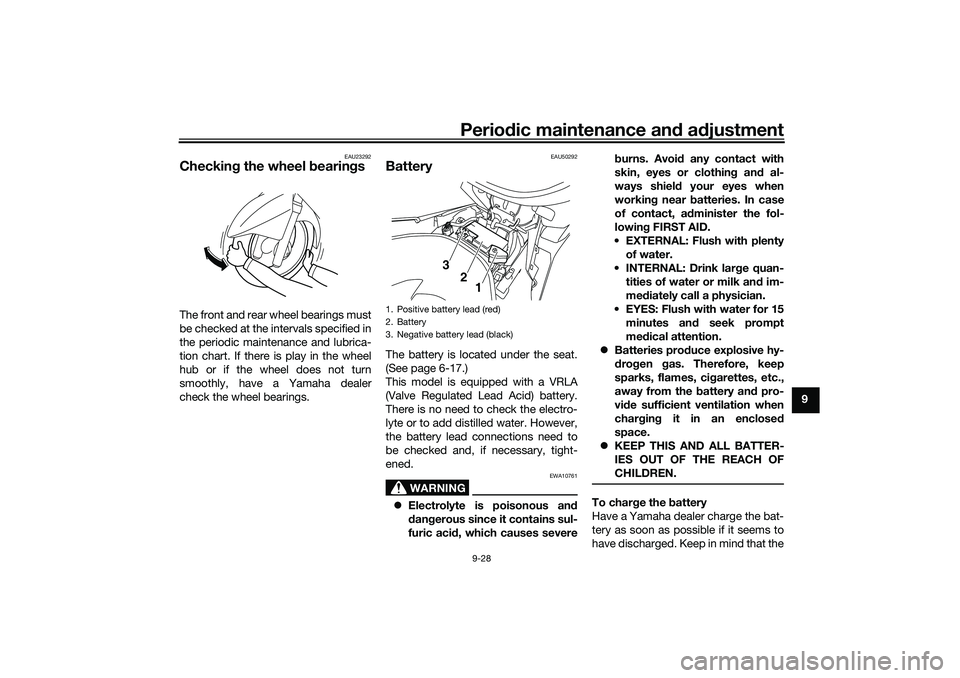
Periodic maintenance and adjustment
9-28
9
EAU23292
Checking the wheel bearingsThe front and rear wheel bearings must
be checked at the intervals specified in
the periodic maintenance and lubrica-
tion chart. If there is play in the wheel
hub or if the wheel does not turn
smoothly, have a Yamaha dealer
check the wheel bearings.
EAU50292
BatteryThe battery is located under the seat.
(See page 6-17.)
This model is equipped with a VRLA
(Valve Regulated Lead Acid) battery.
There is no need to check the electro-
lyte or to add distilled water. However,
the battery lead connections need to
be checked and, if necessary, tight-
ened.
WARNING
EWA10761
Electrolyte is poisonous and
dangerous since it contains sul-
furic acid, which causes severeburns. Avoid any contact with
skin, eyes or clothing and al-
ways shield your eyes when
working near batteries. In case
of contact, administer the fol-
lowing FIRST AID.
EXTERNAL: Flush with plenty
of water.
INTERNAL: Drink large quan-
tities of water or milk and im-
mediately call a physician.
EYES: Flush with water for 15
minutes and seek prompt
medical attention.
Batteries produce explosive hy-
drogen gas. Therefore, keep
sparks, flames, cigarettes, etc.,
away from the battery and pro-
vide sufficient ventilation when
charging it in an enclosed
space.
KEEP THIS AND ALL BATTER-
IES OUT OF THE REACH OF
CHILDREN.
To charge the battery
Have a Yamaha dealer charge the bat-
tery as soon as possible if it seems to
have discharged. Keep in mind that the
1. Positive battery lead (red)
2. Battery
3. Negative battery lead (black)
3
2
1
UBALE0E0.book Page 28 Wednesday, September 30, 2020 1:37 PM
Page 92 of 114
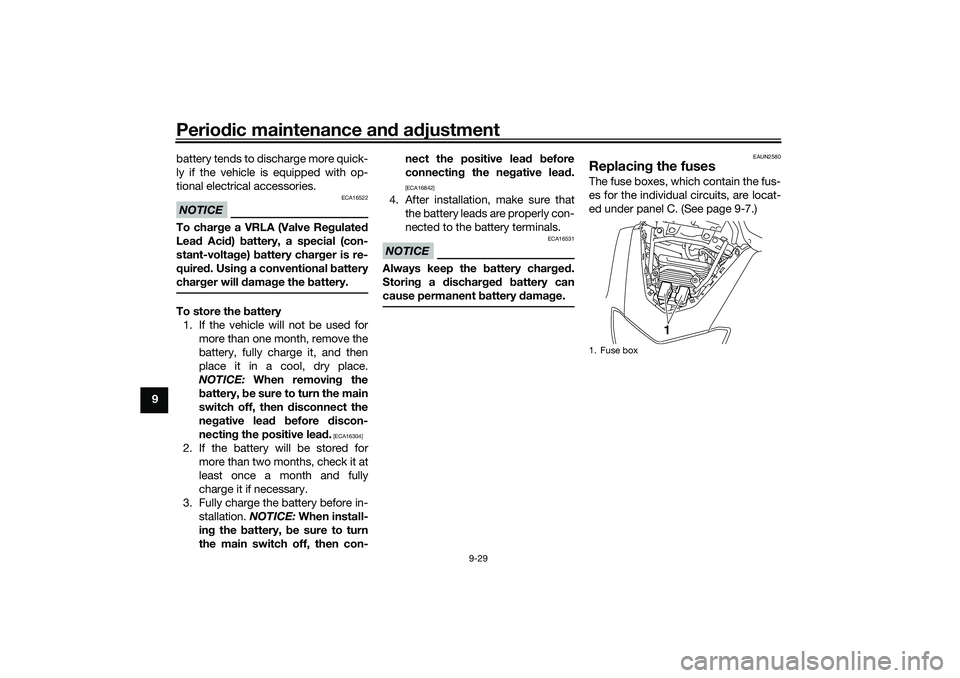
Periodic maintenance and adjustment
9-29
9battery tends to discharge more quick-
ly if the vehicle is equipped with op-
tional electrical accessories.
NOTICE
ECA16522
To charge a VRLA (Valve Regulated
Lead Acid) battery, a special (con-
stant-voltage) battery charger is re-
quired. Using a conventional battery
charger will damage the battery.To store the battery
1. If the vehicle will not be used for
more than one month, remove the
battery, fully charge it, and then
place it in a cool, dry place.
NOTICE: When removing the
battery, be sure to turn the main
switch off, then disconnect the
negative lead before discon-
necting the positive lead.
[ECA16304]
2. If the battery will be stored for
more than two months, check it at
least once a month and fully
charge it if necessary.
3. Fully charge the battery before in-
stallation. NOTICE: When install-
ing the battery, be sure to turn
the main switch off, then con-nect the positive lead before
connecting the negative lead.
[ECA16842]
4. After installation, make sure that
the battery leads are properly con-
nected to the battery terminals.NOTICE
ECA16531
Always keep the battery charged.
Storing a discharged battery can
cause permanent battery damage.
EAUN2580
Replacing the fusesThe fuse boxes, which contain the fus-
es for the individual circuits, are locat-
ed under panel C. (See page 9-7.)1. Fuse box
1
UBALE0E0.book Page 29 Wednesday, September 30, 2020 1:37 PM
Page 93 of 114
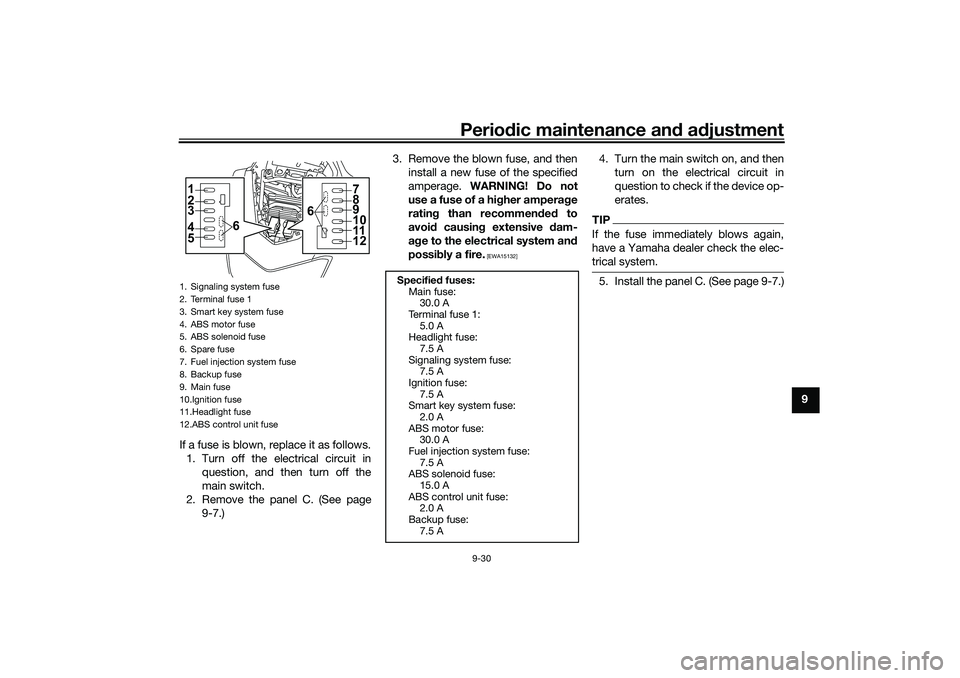
Periodic maintenance and adjustment
9-30
9
If a fuse is blown, replace it as follows.
1. Turn off the electrical circuit in
question, and then turn off the
main switch.
2. Remove the panel C. (See page
9-7.)3. Remove the blown fuse, and then
install a new fuse of the specified
amperage. WARNING! Do not
use a fuse of a higher amperage
rating than recommended to
avoid causing extensive dam-
age to the electrical system and
possibly a fire.
[EWA15132]
4. Turn the main switch on, and then
turn on the electrical circuit in
question to check if the device op-
erates.TIPIf the fuse immediately blows again,
have a Yamaha dealer check the elec-
trical system.5. Install the panel C. (See page 9-7.)
1. Signaling system fuse
2. Terminal fuse 1
3. Smart key system fuse
4. ABS motor fuse
5. ABS solenoid fuse
6. Spare fuse
7. Fuel injection system fuse
8. Backup fuse
9. Main fuse
10.Ignition fuse
11.Headlight fuse
12.ABS control unit fuse1
6 2
3
4
5
7
8
9
11
12 610
Specified fuses:
Main fuse:
30.0 A
Terminal fuse 1:
5.0 A
Headlight fuse:
7.5 A
Signaling system fuse:
7.5 A
Ignition fuse:
7.5 A
Smart key system fuse:
2.0 A
ABS motor fuse:
30.0 A
Fuel injection system fuse:
7.5 A
ABS solenoid fuse:
15.0 A
ABS control unit fuse:
2.0 A
Backup fuse:
7.5 A
UBALE0E0.book Page 30 Wednesday, September 30, 2020 1:37 PM
Page 94 of 114
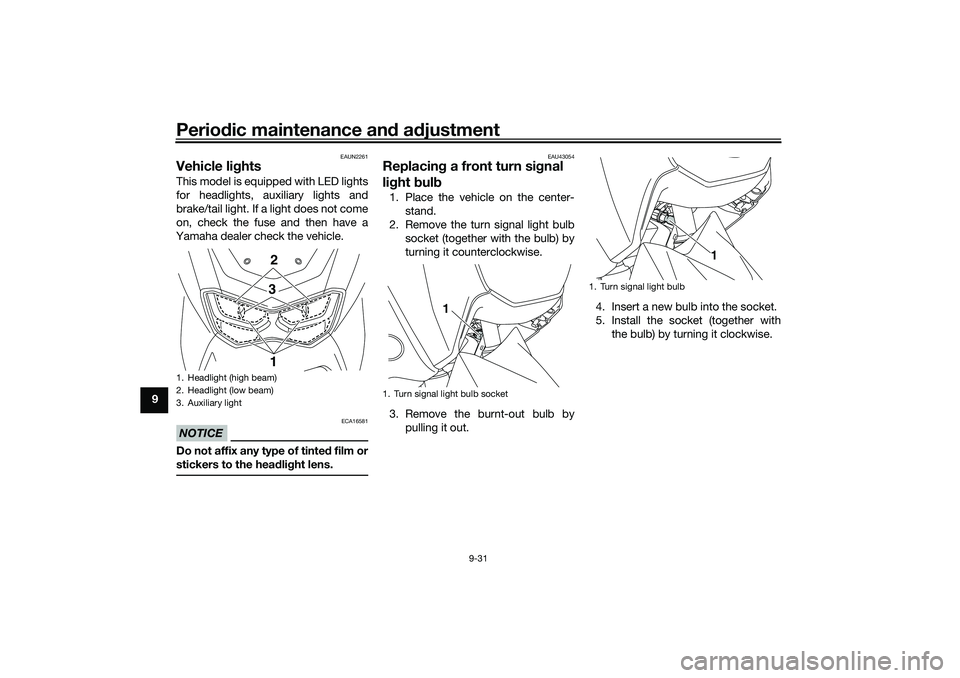
Periodic maintenance and adjustment
9-31
9
EAUN2261
Vehicle lightsThis model is equipped with LED lights
for headlights, auxiliary lights and
brake/tail light. If a light does not come
on, check the fuse and then have a
Yamaha dealer check the vehicle.NOTICE
ECA16581
Do not affix any type of tinted film or
stickers to the headlight lens.
EAU43054
Replacing a front turn signal
light bulb1. Place the vehicle on the center-
stand.
2. Remove the turn signal light bulb
socket (together with the bulb) by
turning it counterclockwise.
3. Remove the burnt-out bulb by
pulling it out.4. Insert a new bulb into the socket.
5. Install the socket (together with
the bulb) by turning it clockwise.
1. Headlight (high beam)
2. Headlight (low beam)
3. Auxiliary light
2
3
1
1. Turn signal light bulb socket
1
1. Turn signal light bulb
1
UBALE0E0.book Page 31 Wednesday, September 30, 2020 1:37 PM
Page 95 of 114
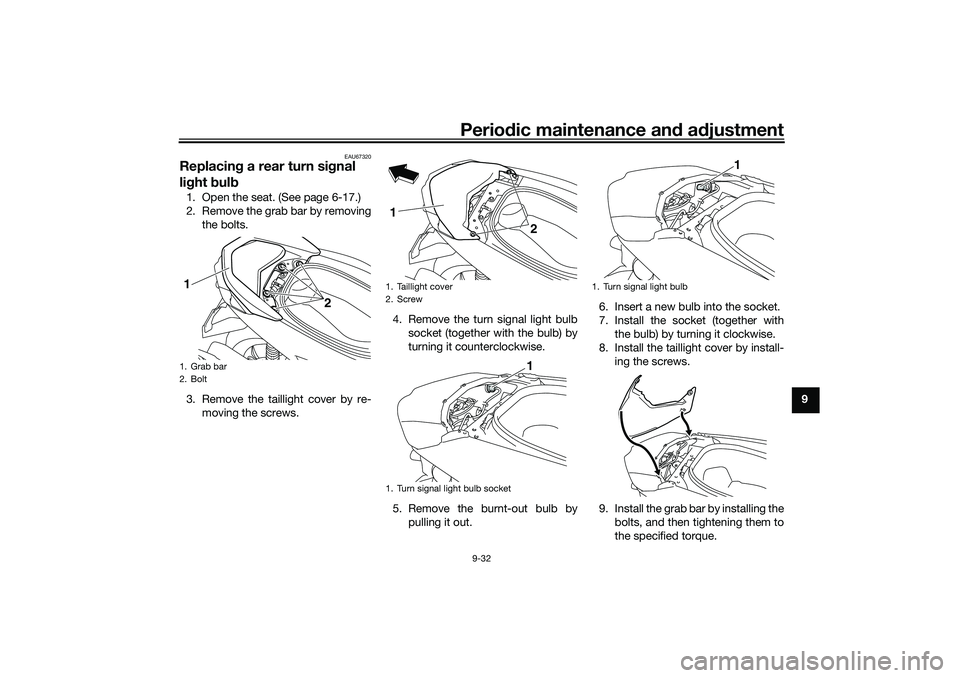
Periodic maintenance and adjustment
9-32
9
EAU67320
Replacing a rear turn signal
light bulb1. Open the seat. (See page 6-17.)
2. Remove the grab bar by removing
the bolts.
3. Remove the taillight cover by re-
moving the screws.4. Remove the turn signal light bulb
socket (together with the bulb) by
turning it counterclockwise.
5. Remove the burnt-out bulb by
pulling it out.6. Insert a new bulb into the socket.
7. Install the socket (together with
the bulb) by turning it clockwise.
8. Install the taillight cover by install-
ing the screws.
9. Install the grab bar by installing the
bolts, and then tightening them to
the specified torque.1. Grab bar
2. Bolt1
2
1. Taillight cover
2. Screw
1. Turn signal light bulb socket1
2
1
1. Turn signal light bulb
1
UBALE0E0.book Page 32 Wednesday, September 30, 2020 1:37 PM
Page 96 of 114
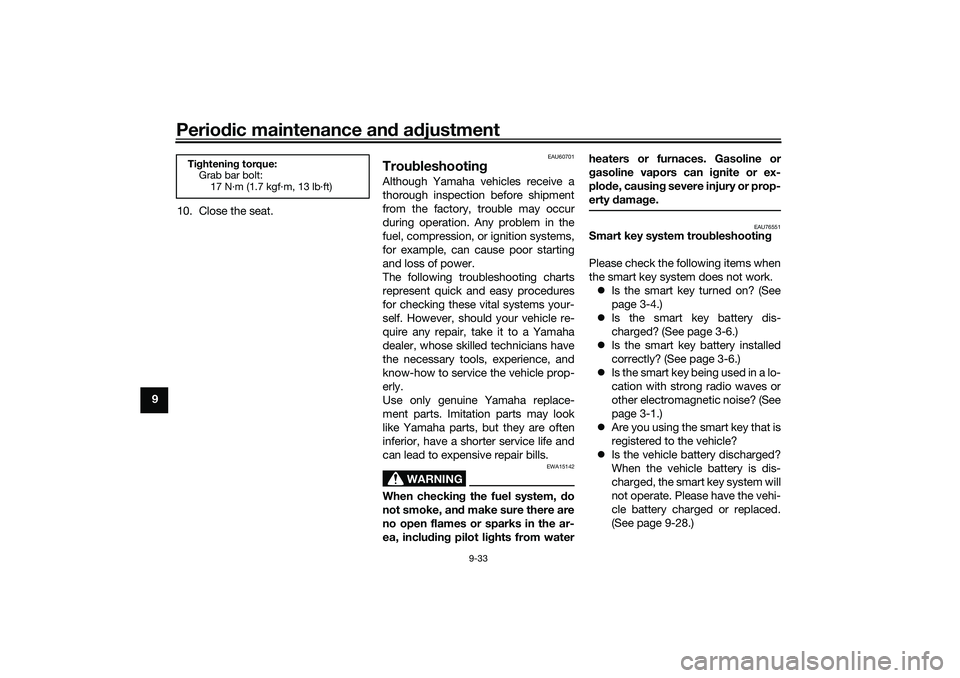
Periodic maintenance and adjustment
9-33
910. Close the seat.
EAU60701
TroubleshootingAlthough Yamaha vehicles receive a
thorough inspection before shipment
from the factory, trouble may occur
during operation. Any problem in the
fuel, compression, or ignition systems,
for example, can cause poor starting
and loss of power.
The following troubleshooting charts
represent quick and easy procedures
for checking these vital systems your-
self. However, should your vehicle re-
quire any repair, take it to a Yamaha
dealer, whose skilled technicians have
the necessary tools, experience, and
know-how to service the vehicle prop-
erly.
Use only genuine Yamaha replace-
ment parts. Imitation parts may look
like Yamaha parts, but they are often
inferior, have a shorter service life and
can lead to expensive repair bills.
WARNING
EWA15142
When checking the fuel system, do
not smoke, and make sure there are
no open flames or sparks in the ar-
ea, including pilot lights from waterheaters or furnaces. Gasoline or
gasoline vapors can ignite or ex-
plode, causing severe injury or prop-
erty damage.
EAU76551
Smart key system troubleshooting
Please check the following items when
the smart key system does not work.
Is the smart key turned on? (See
page 3-4.)
Is the smart key battery dis-
charged? (See page 3-6.)
Is the smart key battery installed
correctly? (See page 3-6.)
Is the smart key being used in a lo-
cation with strong radio waves or
other electromagnetic noise? (See
page 3-1.)
Are you using the smart key that is
registered to the vehicle?
Is the vehicle battery discharged?
When the vehicle battery is dis-
charged, the smart key system will
not operate. Please have the vehi-
cle battery charged or replaced.
(See page 9-28.)
Tightening torque:
Grab bar bolt:
17 N·m (1.7 kgf·m, 13 lb·ft)
UBALE0E0.book Page 33 Wednesday, September 30, 2020 1:37 PM
Page 97 of 114
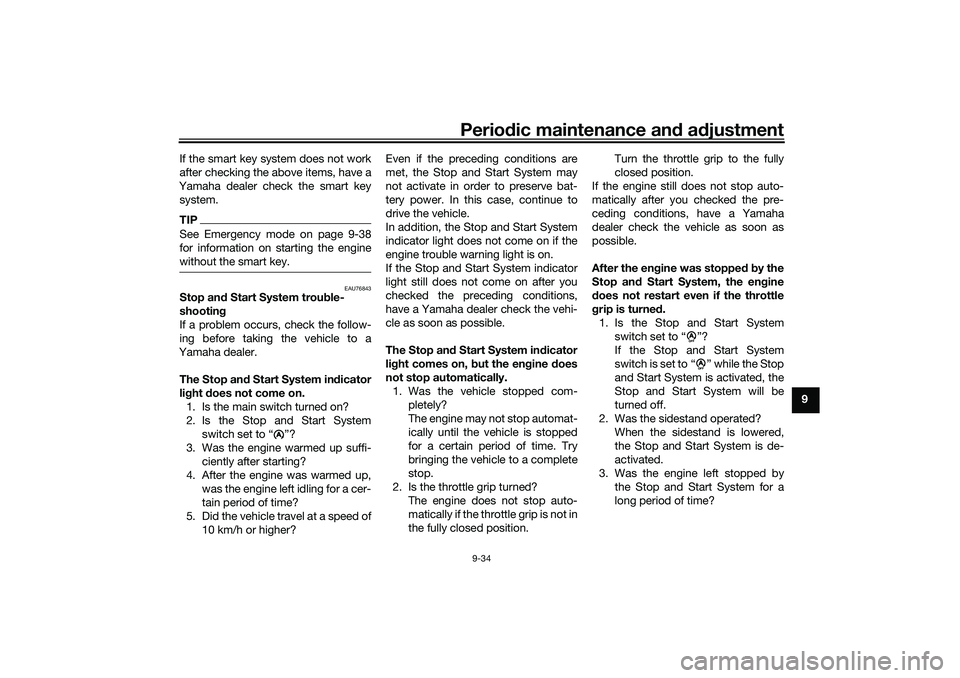
Periodic maintenance and adjustment
9-34
9 If the smart key system does not work
after checking the above items, have a
Yamaha dealer check the smart key
system.
TIPSee Emergency mode on page 9-38
for information on starting the engine
without the smart key.
EAU76843
Stop and Start System trouble-
shooting
If a problem occurs, check the follow-
ing before taking the vehicle to a
Yamaha dealer.
The Stop and Start System indicator
light does not come on.
1. Is the main switch turned on?
2. Is the Stop and Start System
switch set to “ ”?
3. Was the engine warmed up suffi-
ciently after starting?
4. After the engine was warmed up,
was the engine left idling for a cer-
tain period of time?
5. Did the vehicle travel at a speed of
10 km/h or higher?Even if the preceding conditions are
met, the Stop and Start System may
not activate in order to preserve bat-
tery power. In this case, continue to
drive the vehicle.
In addition, the Stop and Start System
indicator light does not come on if the
engine trouble warning light is on.
If the Stop and Start System indicator
light still does not come on after you
checked the preceding conditions,
have a Yamaha dealer check the vehi-
cle as soon as possible.
The Stop and Start System indicator
light comes on, but the engine does
not stop automatically.
1. Was the vehicle stopped com-
pletely?
The engine may not stop automat-
ically until the vehicle is stopped
for a certain period of time. Try
bringing the vehicle to a complete
stop.
2. Is the throttle grip turned?
The engine does not stop auto-
matically if the throttle grip is not in
the fully closed position.Turn the throttle grip to the fully
closed position.
If the engine still does not stop auto-
matically after you checked the pre-
ceding conditions, have a Yamaha
dealer check the vehicle as soon as
possible.
After the engine was stopped by the
Stop and Start System, the engine
does not restart even if the throttle
grip is turned.
1. Is the Stop and Start System
switch set to “ ”?
If the Stop and Start System
switch is set to “ ” while the Stop
and Start System is activated, the
Stop and Start System will be
turned off.
2. Was the sidestand operated?
When the sidestand is lowered,
the Stop and Start System is de-
activated.
3. Was the engine left stopped by
the Stop and Start System for a
long period of time?
A
AA
UBALE0E0.book Page 34 Wednesday, September 30, 2020 1:37 PM
Page 98 of 114
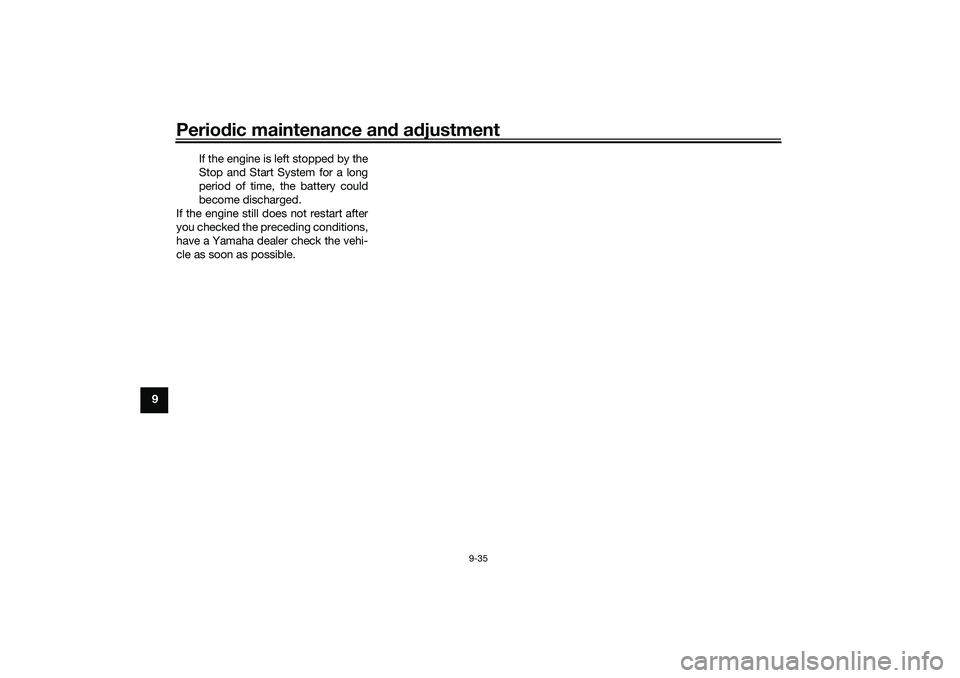
Periodic maintenance and adjustment
9-35
9If the engine is left stopped by the
Stop and Start System for a long
period of time, the battery could
become discharged.
If the engine still does not restart after
you checked the preceding conditions,
have a Yamaha dealer check the vehi-
cle as soon as possible.
UBALE0E0.book Page 35 Wednesday, September 30, 2020 1:37 PM
Page 99 of 114
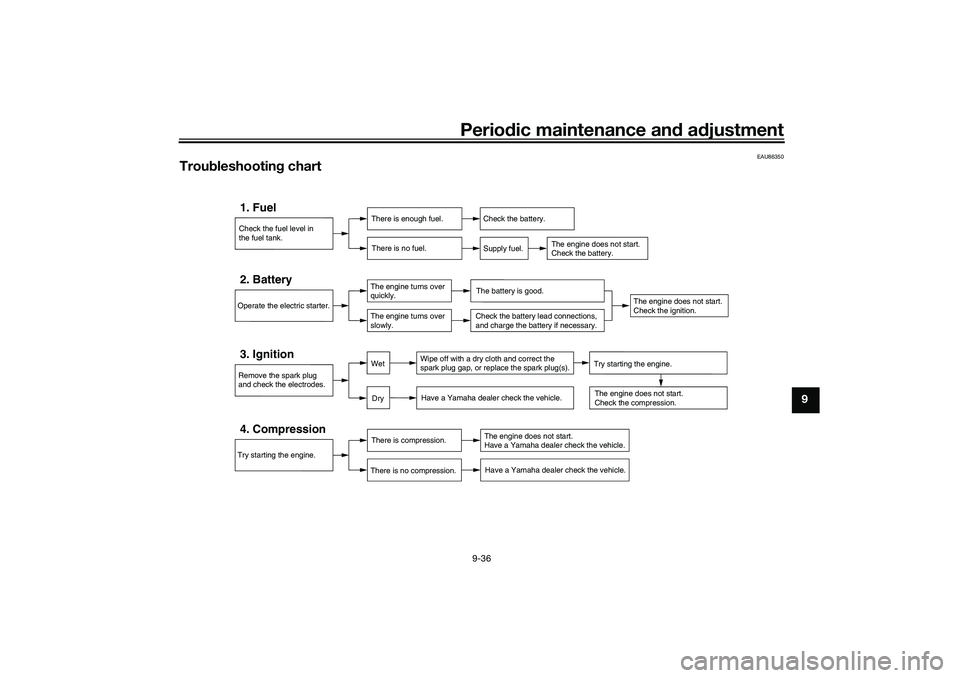
Periodic maintenance and adjustment
9-36
9
EAU86350
Troubleshooting chart
Check the fuel level in
the fuel tank.1. Fuel
There is enough fuel.
There is no fuel.
Check the battery.
Supply fuel.
The engine does not start.
Check the battery.
Try starting the engine.4. Compression
There is compression.
There is no compression.
The engine does not start.
Have a Yamaha dealer check the vehicle.Have a Yamaha dealer check the vehicle.
Remove the spark plug
and check the electrodes.3. Ignition
Wipe off with a dry cloth and correct the
spark plug gap, or replace the spark plug(s).
Have a Yamaha dealer check the vehicle.
The engine does not start.
Check the compression.
Operate the electric starter.2. Battery
The engine turns over
quickly.
The engine turns over
slowly.
The battery is good.
DryWet
Try starting the engine. Check the battery lead connections,
and charge the battery if necessary.
The engine does not start.
Check the ignition.
UBALE0E0.book Page 36 Wednesday, September 30, 2020 1:37 PM
Page 100 of 114
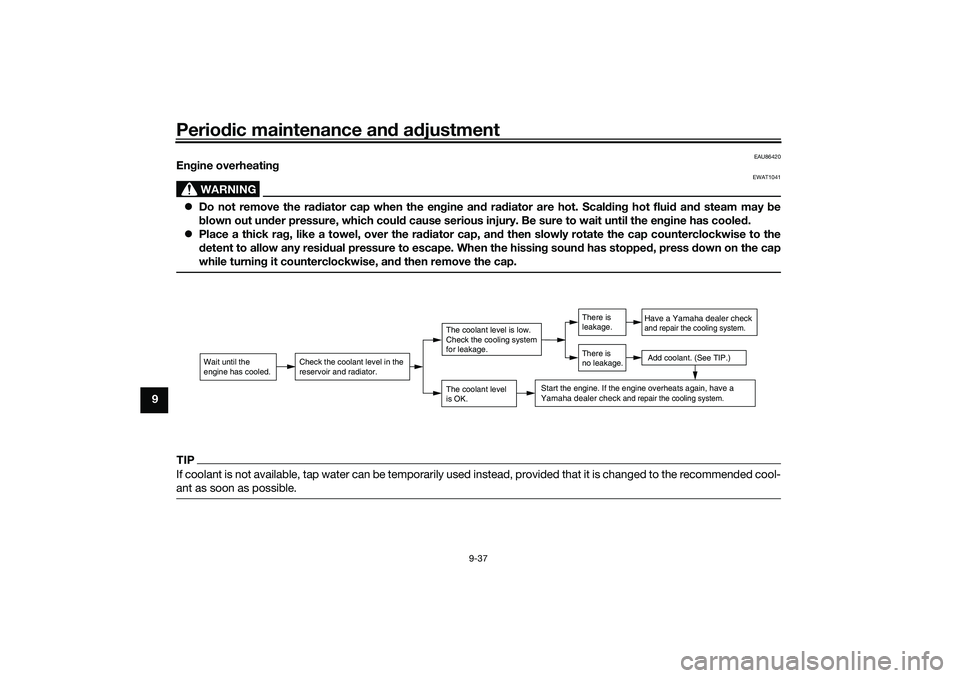
Periodic maintenance and adjustment
9-37
9
EAU86420
Engine overheating
WARNING
EWAT1041
Do not remove the radiator cap when the engine and radiator are hot. Scalding hot fluid and steam may be
blown out under pressure, which could cause serious injury. Be sure to wait until the engine has cooled.
Place a thick rag, like a towel, over the radiator cap, and then slowly rotate the cap counterclockwise to the
detent to allow any residual pressure to escape. When the hissing sound has stopped, press down on the cap
while turning it counterclockwise, and then remove the cap.TIPIf coolant is not available, tap water can be temporarily used instead, provided that it is changed to the recommended cool-
ant as soon as possible.
Wait until the
engine has cooled.
Check the coolant level in the
reservoir and radiator.
The coolant level
is OK.The coolant level is low.
Check the cooling system
for leakage.
Have a Yamaha dealer checkand repair the cooling system.Add coolant. (See TIP.)
Start the engine. If the engine overheats again,
have a
Yamaha dealer check
and repair the cooling system.
There is
leakage.
There is
no leakage.
UBALE0E0.book Page 37 Wednesday, September 30, 2020 1:37 PM